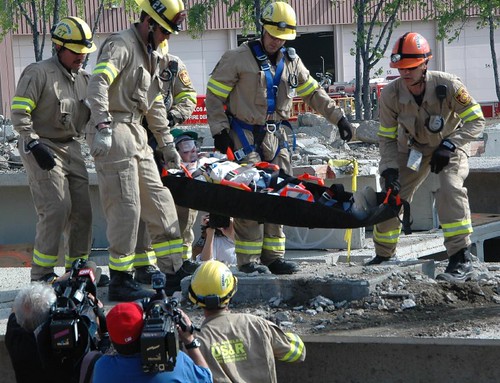Today's magnitude 5.1 earthquake in La Habra reminds us that disasters can strike without warning.
 Many ask: What exactly does the Los Angeles Fire Department do when there’s an earthquake?
Many ask: What exactly does the Los Angeles Fire Department do when there’s an earthquake?
Whenever there is a detectable earthquake tremor anywhere in the city of Los Angeles, the Los Angeles Fire Department initiates the “Emergency Earthquake Mode” (EEM). The quake does not have to reach a certain magnitude to initiate EEM.
When operating in the EEM, Firefighters from all 106 neighborhood fire stations promptly move to a designated safe area and then initiate a “windshield survey” of their District. In this manner, over 470 square miles in the greater Los Angeles area can be assessed in a matter of minutes. The Department’s six helicopters and five fire boats assist the appraisal. Firefighters rapidly assess:
• Transportation infrastructure (freeway over pass, rail lines, and airports).
• Large places of assemblage (stadiums, schools and universities, shopping malls).
• Critical facilities (hospitals, refineries, dams, power lines).
• High density residential (apartments, condominiums).
Once this process is complete, findings are immediately report back to Commanders allowing areas of concern to be quickly addressed.
What would you do...
...if basic services - water, gas, electricity and telephones - were entirely cut off? ...if roads were impassible or neighborhood firefighters were committed to major emergencies and unable to reach you right away?
The answer is Preparedness!
The men and women of the Los Angeles Fire Department want you and your family to be safe. Here are some tips for getting and staying prepared:
- Know the types of disasters that can occur in your community.
- Make a family emergency plan that coordinates with your school, work and neighborhood plans. Practice them with the every member of your household - and don't forget your pets!
- Create a disaster supplies kit that includes enough supplies for each family member for at least three days. Remember to check your kit every six months.
- Teach children about emergencies, including when to call for help, where you'll meet and how you'll communicate following a disaster.
- If you commute to work, know alternate routes and carry appropriate supplies, such as a disaster kit in your car - and a compact kit with bare essentials such as a small flashlight and whistle when on public transportation.
The LAFD suggests these resources to help you prepare:
- American Red Cross - Plan and Prepare
- CDC - Emergency Preparedness and Response
- CERT - Community Emergency Response Teams (CERT - LA)
- Earthquake Country Alliance
- Emergency Preparedness for People With Disabilities
- FEMA - Are You Ready? Guide
- Ready Kids
- LAFD - Emergency Preparedness Booklet
- MySafeLA.org
- Ready.gov
- ReadyLA.org
Submitted by Erik Scott, Spokesman
Los Angeles Fire Department
500 East Temple Street
Los Angeles, CA 90012
__._,_.___
No comments:
Post a Comment